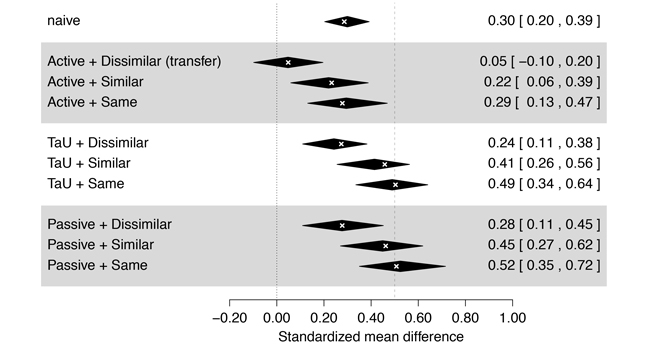Image: Predictions from a classical naive intercept-only random effects model (top) versus predictions from a mixed model with main effects of control group and outcome-training similarity. Black diamonds are means and 95% credible intervals from “norm” studies and white crosses are means based on all studies. Variance of the latter estimates are marginally smaller than the black diamonds and the estimates are similar. The crucial contrast is between the naive estimate and the transfer effect - the top two diamonds.
Jonas Lindeløv: Computer- and Suggestion-based Cognitive Rehabilitation following Acquired Brain Injury.
Impairment of working memory and attention are frequent sequelae of acquired brain injury experienced by millions of people all over the world. However, there are currently no cost-effective treatments for such impairments. This thesis is an empirical exploration of two candidate cost-effective treatments: computer-based and suggestion-based treatments.
Based on negative findings from a RCT and a comprehensive meta-analysis, it is concluded that computer-based training in general is unsuitable as a means to rehabilitate high-level cognitive functions in patients with acquired brain injury. A pervasive problem in drill-and-practice interventions is to factor out task-specific effects when assessing transfer-effects. I present four methodological criteria which must be fulfilled to claim that a transfer effect was found.
In a third study, we used hypnotic suggestions to target impaired working memory capacity. There was a unique and persistent effect of these targeted hypnotic suggestions as compared to a closely matched hypnotic control condition and very large effects compared to a passive control group.
I conclude that there is solid evidence that computer-based methods are ineffective and that positive reports were largely driven by methodological inadequacies. In contrast, there is encouraging, though preliminary, evidence that a suggestion-based method was highly effective for improving working memory performance following acquired brain injury.

